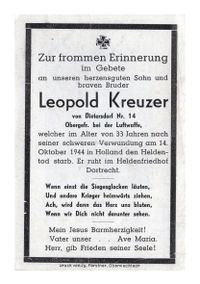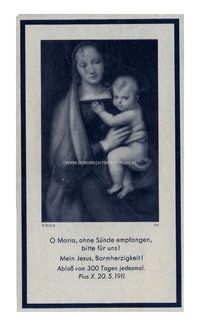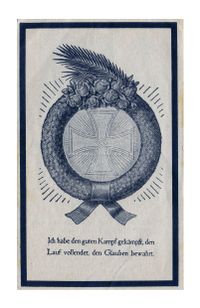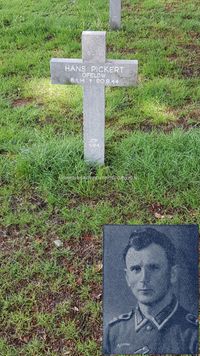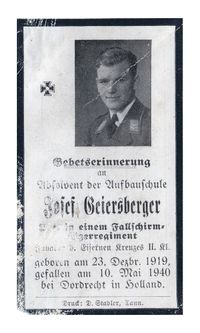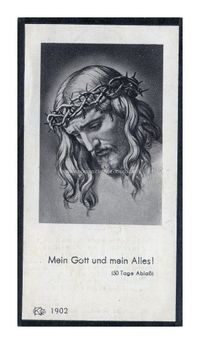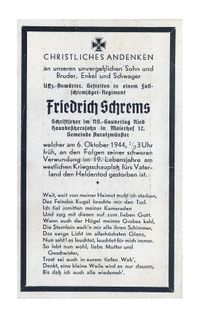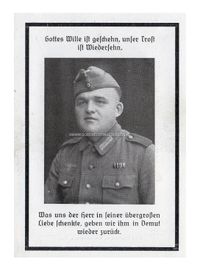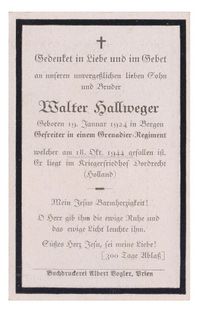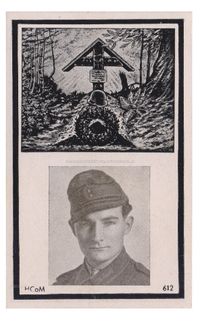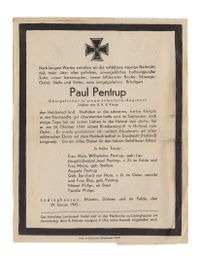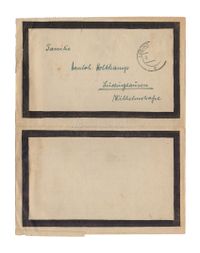Deathcards German.
During the war, many soldiers died, and to commemorate these soldiers, deathcards, often called "bidpentjes" in Dutch or "sterbebilder" in German, were printed. Both on the Dutch side, shortly after May 1940, and on the German side, these deathcards were used.
The deathcards often mentioned the name of the deceased soldier, the date and place of death, and sometimes the cause of death. They also frequently included the soldier's rank, any medals they had received, and their final resting place. For German soldiers, the final resting place was often the place where they died, while Dutch soldiers were often buried in their hometowns.
Obergefreiter Leopold Kreuzer.
The deathcard shown above is the deathcard of Obergefreiter Leopold Kreuzer. Kreuzer was born on August 15, 1911, and was 33 years old when he was killed on October 14, 1944. He was a member of 8230-Fl.Ausb.Btl.12. The cause of his death was a severe injury, though it is not known, or at least not known to us, what exactly caused this severe injury. One possibility is that Obergefreiter Kreuzer was one of the German soldiers who were wounded when the Zwijndrecht bridge was accidentally blown up by German soldiers in September 1944. It is possible that he initially survived the accident but later succumbed to his injuries. Another possibility is that he was transferred from the nearest front to a hospital in Dordrecht, where he passed away. Initially, Gefreiter Kreuzer was buried at the general cemetery in Dordrecht but was later transferred to Ysselsteyn in Limburg. His grave is located in Block CO - Row 10 - Grave 238. *1
Possibly, there are people who may have more information about the nature of Obergefreiter Kreuzer's injury.
Obergefreiter Alois Pflugmacher.
The prayer card above is of Obergefreiter Alois Pflugmacher. It is strange that Mr. Pflugmacher cannot be found in the online archives of the Deutsche Volksbund für Deutsche Kriegsgräberfürsorge.*1 Further search in the casualty register of the Dordtse 40-45 museum also does not yield any results.*2 However, it is noteworthy that the register contains 14 other casualties who died on the same date without a known location of death. This raises several questions. The prayer card states that Obergefreiter Pflugmacher was killed in action on the Hollandsche Diep and was part of a FLAK unit (Flieger abwehr kanone - antiaircraft). It is possible that he was part of the FLAK air defense guarding the Moerdijk bridges and died during an Allied air raid.
However, there is another possibility. Further internet research has shown that on November 4th, there was an Allied air attack on the village of Zevenbergen.*3 This resulted in many casualties. It strongly suggests that Obergefreiter Pflugmacher was one of those killed. In that case, it is still peculiar that the Hollandsche Diep is listed as the location of death.
If we search the data from the Dordtse 40-45 museum in the search engine of the Deutsche Volksbund für Kriegsgräberfürsorge, we come to the following conclusion: Out of the 14 casualties on November 4, 1944, that we find in the casualty lists of the Dordtse museum, 6 cannot be traced in the register of the Volksbund für Deutsche Kriegsgräberfürsorge. For only one soldier (Ernst Amrhein), the Volksbund has a known location of death, namely Dordrecht. The remaining 8 casualties are listed in the casualty register of the Volksbund, but their exact location of death is unknown.
Ernst Amrhein: Location of death Dordrecht / Listed in Volksbund register.
Willi Behnke: Unknown location of death / Not listed in Volksbund register.
Otto Dietrich: Unknown location of death / Listed in Volksbund register.
Walter Eitelbus: Unknown location of death / Not listed in Volksbund register.
Josef führmann: Unknown location of death / Not listed in Volksbund register.
Karl van de Kamp: Unknown location of death / Not listed in Volksbund register.
Johannes Koenig: Unknown location of death / Not listed in Volksbund register.
Konrad Kühbauch: Unknown location of death / Listed in Volksbund register.
Alfred Merle: Unknown location of death / Listed in Volksbund register.
Walter Reichle: Unknown location of death / Listed in Volksbund register.
Edmund Risler: Unknown location of death / Listed in Volksbund register.
Franz Scheckenbach: Unknown location of death / Listed in Volksbund register.
Bruno Schmidt: Unknown location of death / Listed in Volksbund register.
Engelbert Teil: Unknown location of death / Not listed in Volksbund register.
In the later years of the war, the quality of casualty registration deteriorated. Due to chaotic battles and rapid retreats, German soldiers often remained on the battlefield and the Allies naturally made less effort to identify the German dead compared to the Germans themselves. The author of this website suspects that Obergefreiter Alois Pflugmacher most likely had a hasty and makeshift burial, possibly in an assumed field grave, if there was any burial at all. Afterwards, the remains were presumably transferred to Ysselsteyn, where he was buried as an unknown soldier along with the six others who are also not listed in the Volksbund register.
Obergefreiter Alois Pflugmacher was killed at the age of 24 near the Hollandsche Diep. We are very curious if someone can provide further information about his person.
Oberfeldwebel Hans Pickert.
Oberfeldwebel Hans Pickert was born on January 8, 1944, in Nagel. He was part of the 8th Company of Eisenb.Pi.Rgt 6 and was killed on September 20, 1944, in Dordrecht. On September 20, 1944, preparations were being made to blow up the Zwijndrecht railway bridge. The Allies had started Operation Market Garden a few days earlier on September 17. An explosion occurred accidentally, partially damaging the bridge and causing the deaths of three German soldiers who were on the bridge. Oberfeldwebel Hans Pickert was one of them.*4
He was initially buried at the general cemetary in Dordrecht and later reburied at the German military cemetery in Ysselsteyn after the war. He is buried in block CP, row 1, grave 24.
Oberjäger Josef Geiersberger.
Josef Geiersberger was part of 2./FJR 1 (2nd Company of Fallschirmjäger Regiment 1) which landed with their parachutes in the polder east of Wieldrecht on May 10, 1940. The company soon received orders to clear the area along the Rijksstraatweg towards Dordrecht. Around Gravestein, the company made contact with the 1st section of 2-III-34 RI, engaging in a fight that quickly ended in favor of 2./FJR 1. They pushed forward to the Amstelwijck villa park, where the headquarters of I-28.RI under Major van Hoek was located, along with a bunker complex. Another battle ensued between the Dutch forces at the location and the commander of 2./FJR 1, Leutnant Graf von den Blücher, who led a fierce assault on the headquarters and its bunkers with his troops. With support from the rest of the 2nd Company and elements of 4./FJR 1, they completely overwhelmed the Dutch occupation of the headquarters and the bunker complex.*5 Although these battles resulted in success for 2./FJR 1, they were not without casualties. Oberjäger Geiersberger was one of the paratroopers who were killed during the fighting around the headquarters and bunker complex at Amstelwijck. He was initially buried at the general cemetery in Dordrecht and later reburied at Ysselsteyn: Block CP, Row 7, Grave 172. *6
Stabsfeldwebel Martin Ulrich.
Stabsfeldwebel Martin Ulrich was born on October 20, 1908, in Ketterhausen. In May 1940, he was a member of 2/FeldgenAbt (Feldgendarmerie Abteilung) 682 in the Netherlands. Interestingly, the deathcard mentions his date of death as May 18, 1940, in Rotterdam, yet it states that he was buried in Dordrecht. However, the website www.grebbeberg.nl indicates a different location, stating that he died on May 18, 1940, in Dordrecht due to injuries. Both locations are noteworthy. It is likely that Stabsfeldwebel Ulrich was wounded during May 1940 in Dordrecht or Rotterdam and died in a medical facility or hospital in Dordrecht on May 18, 1940. He was initially buried at the general cemetary in Dordrecht, and after the war, his grave was relocated to the German military cemetery in Ysselsteyn, where he still rests today. His grave number is Block CP, Row 6, Grave 127. *7 *8
Unteroffizier Friendrich Schrems.
Unteroffizier Friedrich Schrems was born on December 5, 1925, in Zell an der Mosel, Germany. He was a part of the 324-12/Fl.Ausb.Rgt 53. In June 1944, this unit was converted into the Luftgau-Feld-Regiment-Belgien-Nordfrankreich. On September 9, 1944, this unit was disbanded, and the remaining units were absorbed into Fallschirmjäger divisions.*9 The exact circumstances of his death are unknown, but his deathcard states that he passed away at the age of 19 from injuries sustained on the Western Front. It is likely that as a young soldier, he was part of a Fallschirmjäger division, got wounded, and was taken to a military hospital in Dordrecht. It was there that he succumbed to his injuries. He was initially buried at the general cemetary in Dordrecht. After the war, he was reburied at the German military cemetery in Ysselsteyn. He is buried in Block CP, Row 1, Grave 13..*10
Obergefreiter Ferdinand Mitterer.
Obergefreiter Ferdinand Mitterer was born on June 13, 1912, in Lochen, Germany. He was a member of 861-1./N.E.A. (Nachrichten Ersatz Abteilung). On May 5, 1945, he lost his life during a confrontation with members of the Binnenlandse Strijdkrachten (Dutch domestic forces) in Oud-Alblas. His body was found in the farm of Klaas Baan. As an act of retaliation, the remaining German forces set the farm on fire. Obergefreiter Mitterer was initially buried at the general cemetary in Dordrecht. After the war, he was transferred to the German military cemetery in Ysselsteyn. He is buried in Block CN, Row 3, Grave 64.. *11
Gefreiter Fritz Hellauer.
Gefreiter Fritz Hellauer was a weaver by profession and came from Hartmannsreuth. He was born on November 11, 1908. He served in an infantry regiment. According to the memorial card, he died on January 21, 1945, in Dordrecht. However, he is not registered in the Volksbund Für Deutsche Kriegsgräberfürsorge (German War Graves Commission). This is not uncommon, though. He is also not mentioned in the casualty lists of the Museum 1940-1945 in Dordrecht. What is noteworthy is that his date of death is one day before the January bombing of Dordrecht. Since the recording of German military casualties was particularly chaotic in the last months of the war, it is possible that Gefreiter Hellauer perished in that bombing, and the date on his memorial card may be incorrect. This is a theory. It is also possible that Gefreiter Hellauer died in one of the hospitals in Dordrecht. It is unknown where Fritz Hellauer was buried, and whether he ever received a grave. The memorial card is shrouded in mystery.
Gefreiter Walter Hallweger.
Gefreiter Walter Hallweger was born on January 19, 1924 in Bergen (Affing), Landkreis Aichach-Friedberg, Bavaria. He served with 386-2/St.Kp.Grenadier.Ersatz.Batalion.163, which was likely the unit he joined and the unit listed on his identification tag. On October 18, 1944, Gefreiter Hallweger was killed in action in Dordrecht at the age of twenty. He was initially buried in the general cemetery in Dordrecht. On August 14, 1947, he was reburied at the German military cemetery in Ysselsteyn. He is buried in block CP - row 10 - grave 232. *13
Sterbebrief ( Death letter )Obergefreiter Paul Petrup.
This is the death notice of Obergefreiter Paul Pentrup. The letter is addressed to the Hauloh-Holtkamp family residing on Wilhelmstrase in Lüdinghaüsen. Obergefreiter Paul Pentrup was born on March 26, 1910, in Lüdinghausen, Kreis Coesfeld, Nordrhein-Westfalen, Germany. He was a part of 294-L.Sch.Btl.676 (Landes Schutzen Batalion). This unit was stationed in Dordrecht in 1944. After fighting in Normandy and being on leave in Germany in September, Obergefreiter Pentrup was killed on October 24, 1944, during the Allied bombing of Merwesteijn Park. This location housed the headquarters of the German 15th Army, which was accommodated in the five bunkers built on the complex. On October 24, 1944, five squadrons of Hawker Typhoons from the Royal Airforce carried out a bombing raid on the headquarters at the request of the resistance in Dordrecht. The damage was immense. Although according to the Dordrecht resistance, there were numerous German casualties, including generals, the civilian population suffered the most. The estimated number of fatalities amongst civilians is 69. Obergefreiter Paul Pentrup was one of the German casualties as a result of the bombing. He was buried with military honors at the General Cemetery in Dordrecht. On August 20, 1947, Obergefreiter Paul Pentrup was reburied at the German Military Cemetery in Ysselsteyn. To this day, he remains buried in Plot CP, row 11, grave 272. *12
©2017-2024 :Https://www.Dordrechtindeoorlog.nl: ( There is a copyright on the content of this website. This content is not to be shared, duplicated or published withouth the explicit permission of the author of this website. If you have any requests you can email to: Info@Dordrechtindeoorlog.nl or look on : www.dordrechtindeoorlog.nl/termsofuseforthecontentonthiswebsite.
*1 Source : Volksbund Deutsche Kriegsgräberfürsorge.
*2 Source: Verlieslijst museum 1940-45 Dordrecht.
*3 Source: Canon van Moerdijk.
*4 Source: The book : 40-45 by Wim van Wijk
*5 Source: Zuidfrontholland1940 - Vak Wieldrecht 1e fase.
*6 Source: Zuidfrontholland1940 - Josef Geiersberger.
*7 Source: Grebbeberg.nl/gesneuvelden.
*8 Source: Findagrave.com/Martin Ulrich.
*9 Source: Lexikon der Wehrmacht.
*10 Source: Findagrave.com/Friedrich Schrems.
*11 Source: Findagrave.com/Ferdinand Mitterer.
*12 Source: Findagrave.com/Paul Pentrup.
*13 Source: Findagrave.com/Walter Hallweger.

